1996 PONTIAC GRAND-AM seats
[x] Cancel search: seatsPage 3 of 356
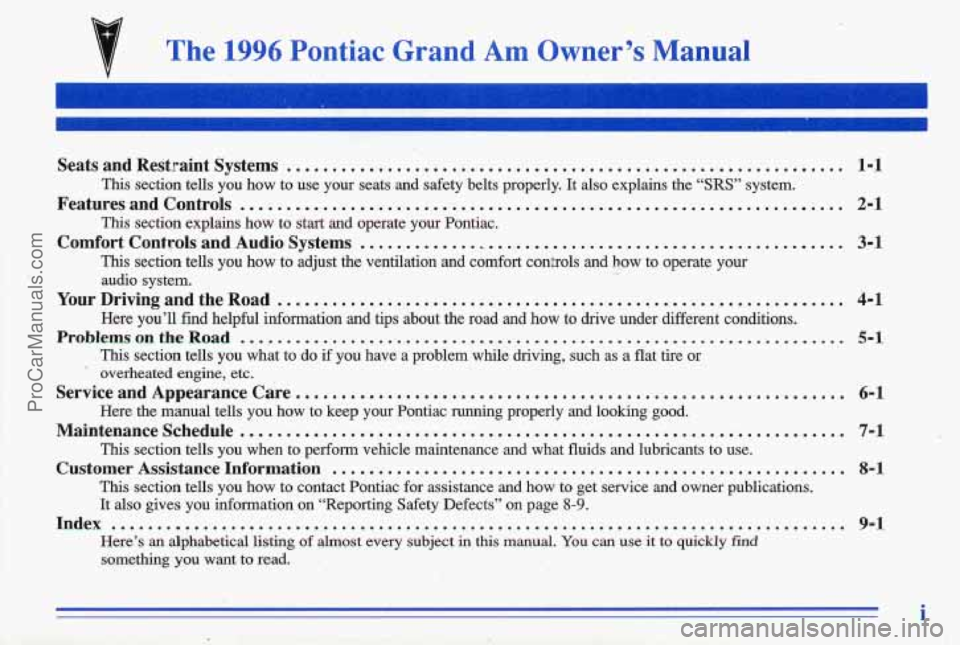
The 1996 Pontiac Grand Am Owner’s Manual
Seats and Restraint Systems ............................................................. 1-1
Features and Controls .................................................................. 2-1
Comfort Controls and Audio Systems ..................................................... 3-1
This section tells you how to use your seats and safety belts properly. It also explains the “SRS” system.
This section explains how to start and operate your Pontiac.
This section tells you how to adjust the ventilation
and comfort conkols and how to operate your
audio system.
Here you’ll find helpful information and tips about the road\
and how to drive under different conditions.
This section tells you what to do if you have a problem while driving, such as a flat tire or
Your Driving and the Road ............................................................... 4-1
ProblemsontheRoad .................................................................. 5-1
’ overheated engine, etc.
Service and Appearance Care ............................................................ 6-1
Maintenanceschedule.................................................... \
.............. 7-1 , ., ,(
Customer Assistance Information ........................................................ 8-1
Here the manual tells you how to keep your Pontiac running pr\
operly and looking good.
This section tells you when
to perform vehicle maintenance and what fluids and lubricants to use.
This section tells you how to contact Pontiac for assistance and how to get serv\
ice and owner publications.
It also gives you information on “Reporting Safety Defects” o\
n page
8-9.
Here’s an alphabetical listing of almost every subject in this manual. You can use it to quickly find
something you want to read.
Index ........................................................................\
........ 9-1
i
ProCarManuals.com
Page 9 of 356
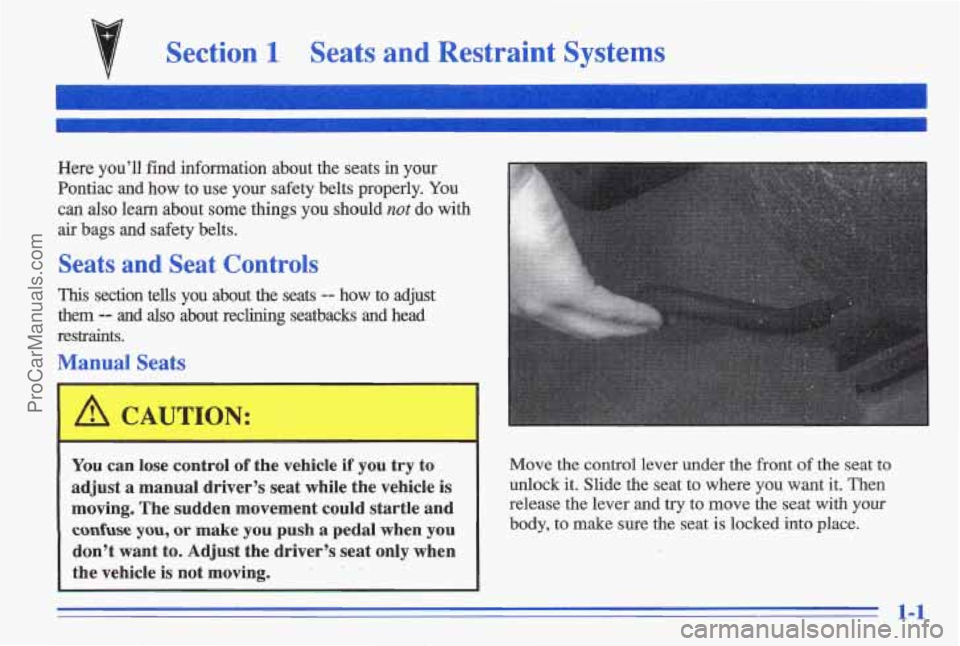
Section 1 Seats and Restraint Systems
Here you’ll find information about the seats in your
Pontiac and how
to use your safety belts properly. You
can also learn about some things you should not do with
air bags and safety belts.
Seats and Seat Controls
This section tells you about the seats -- how to adjust
them
-- and also about reclining seatbacks and head
restraints.
Manual Seats
I
A CAUTION:
You can lose control of the vehicle if you try to
adjust a manual driver’s seat while the vehicle is
moving. The sudden movement could startle and
confuLse you, or make you push a pedal when you
don’t want to. Adjust the driver’s seat only when
the vehicle is not moving.
I
Move the control lever under the front of the seat to
unlock it. Slide the seat to where you want it. Then
release the lever and try to move the seat with
your
body, to make sure the seat is locked into place.
1-1
ProCarManuals.com
Page 14 of 356
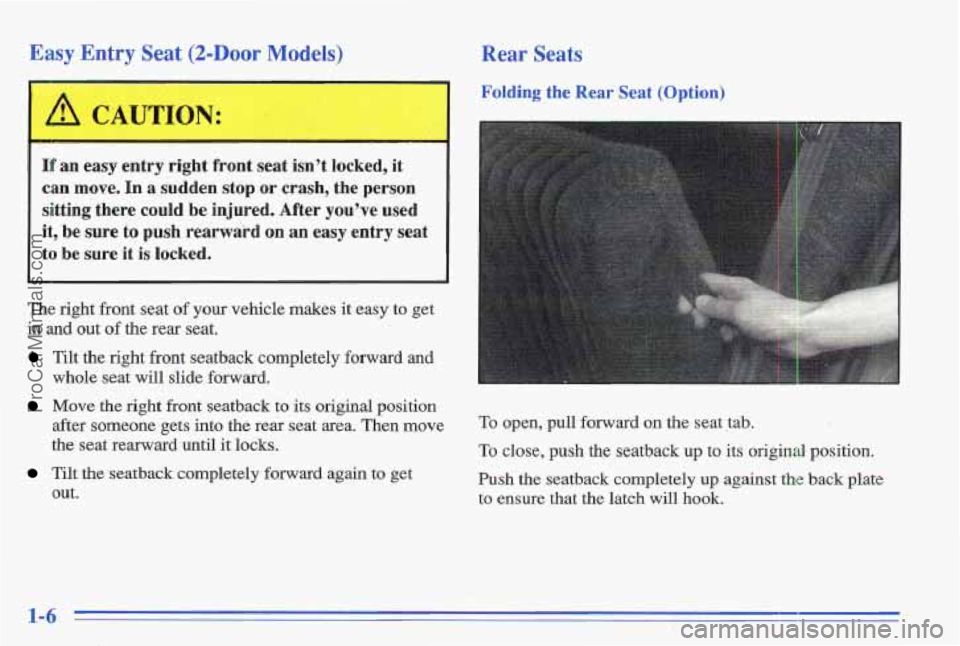
Easy Entry Seat (2-Door Models)
I .>
Q:
11 an easy entry rlgnr rronr seat isn’t locked, it
can move. In a sudden stop or crash, the person
sitting there could be injured. After you’ve used
it,
be sure to push rearwa‘rd on an easy entry seat
to be sure it is locked.
Rear Seats
The right front seat of your vehicle makes it easy to get
in and out of the rear seat.
Tilt the right front seatback Completely forward and
whole seat will slide forward.
Folding the Rear Seat (Option) , ~~ ?.L-
Move the right front seatback to its original position
after someone
gets into the rear seat area. Then move TO open, pull forward on the seat tab.
the seat rearward until it locks. To close, push the seatback up to its original. position.
Push the seatback completely up against the back plate
to ensure that the latch will, hook. Tilt the seatback completely forward again to get
out.
1-6
ProCarManuals.com
Page 20 of 356
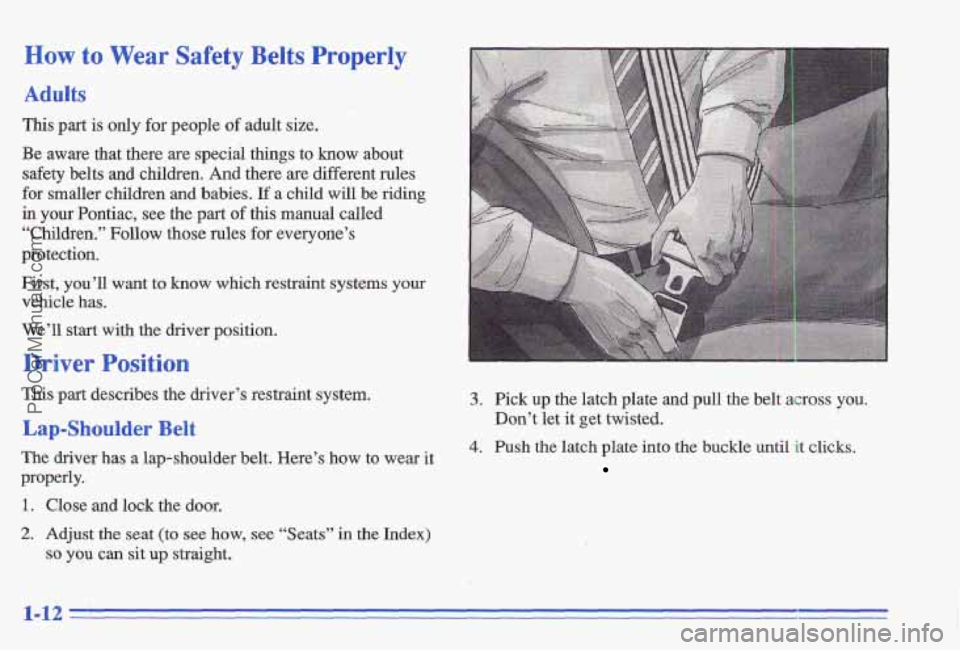
How to Wear Safety Belts Properly
Adults
This part is only for people of adult size.
Be aware that there are specid things to know about
safety belts and children. And there are different des
for smaller children and babies. If a child will be riding
in your Pontiac, see the part of this manual called
“Childrin.’’ Follow those rules
for everyone’s
protection.
’
First, you’ll want to know which restrakt systems your
vehicle has.
We’ll
start with the driver position.
,
Driver Position
This part describes the drives’s restraint system.
Lap-Shoulder Belt
The driver has a lap-shoulder belt. Here’s how to wear it
properly.
1. Close and lock the door.
2. Adjust the seat (to see how, see “Seats” in the Index)
so you can sit up straight.
3. Pick up the latch plate and pull the belt across you.
4. Push the latch plate into the buckle until it clicks.
Don’t let it get twisted.
, .(’.
1-12
ProCarManuals.com
Page 49 of 356
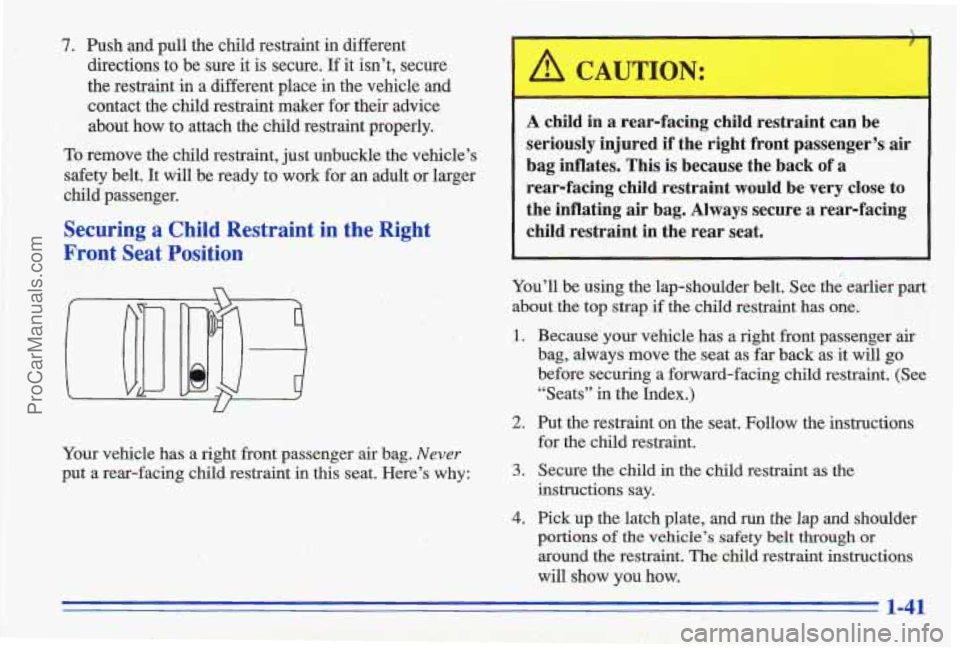
7. Push and pull the child restraint in different
directions to be sure it
is secure. If it isn't, secure
the restraint in a different place
in the vehicle and
contact the child restraint maker for their advice
about how to attach the child restraint properly.
To remove the child restraint, just unbuckle the vehicle's
safety belt. It
will be ready to work for an adult or larger
child passenger.
Securing.a Child Restraint in the Right
Front Seat Position
Your vehicle has a right front passenger air bag. Never
put a rear-facing child restraint in this seat. Here's why:
,I I
A child in a rear-facing child restraint can be
seriously injured if the right front passenger's air
bag inflates. This
is because the back of a
rear-facing child restraint would
be very close to
the inflating air bag. Always secure a rear-facing
child restraint in the rear seat.
you'll be using the lap-shoulder belt. See the earlier part
about the top strap if the child restraint has one.
1. Because your vehicle has a right front passenger air
bag, always move the seat as far back as. it will
go
before securing a forward-facing child restraint. (See
"Seats"
in the Index.)
2. Put the restraint on the seat. Follow the instructions
3. Secure the child in the child restraint as the
for the child restraint,
instructions say.
4. Pick up the latch plate, and run the lap and shoulder
portions
of the vehicle's safety belt through or
around the restraint. The child restraint instructions
..'"'! .- will show you how.
- A-
1-41
ProCarManuals.com
Page 74 of 356
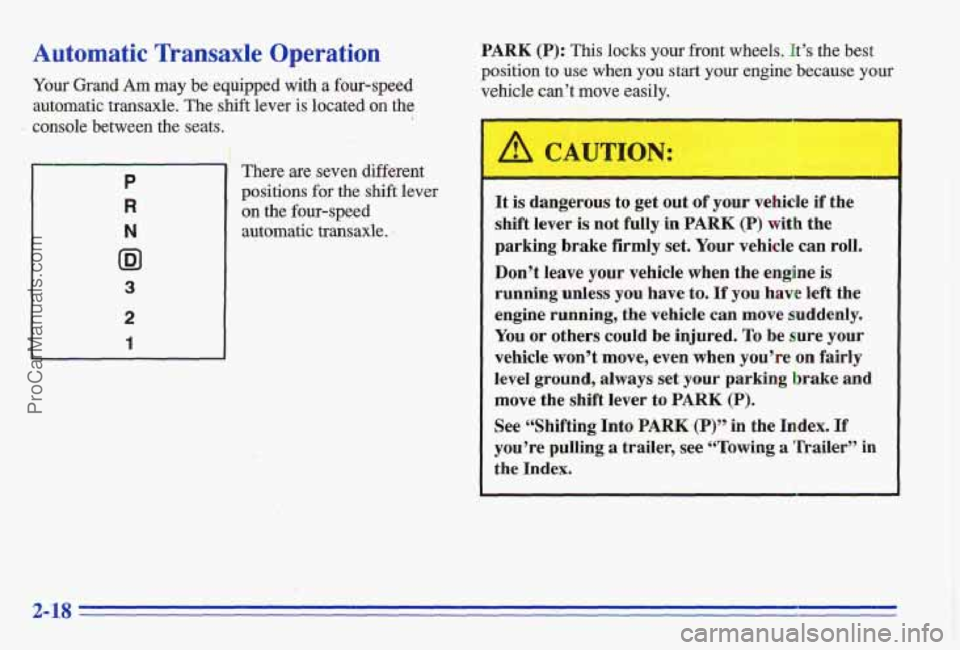
Automatic Transaxle Operation
Your Grand Am may be.equipped with a four-speed
automatic transaxle. The shift lever
is located on the
console between the seats. i
P
R
N
ID1
3
2
1
There are seven different
positions
for the shift lever
on the four-speed
autom&ic transaxle.
PARK (P): This locks your front wheels. It’s the best
position to use when you start your engine because your
vehicle can’t move easily.
It is dangerous to get out of your vehicle if the
shift lever
is not fully in PARK (P) with the
parking brake firmly set. Your vehicle can roll.
Don’t leave your vehicle when the engine is
running unless you have to, If you have left the
engine running, the vehicle can move suddenly.
You or others could be injured. To be sure your
vehicle.won’t move, even when
you’re on fairly
level ground, always set your parking brake and
move the shift lever to PARK (P).
See &‘Shifting Into PARK,(P)” in the Index, Tf
you’re pulling a trailer, see “Towing a in
the Index.
2- 18
ProCarManuals.com
Page 128 of 356
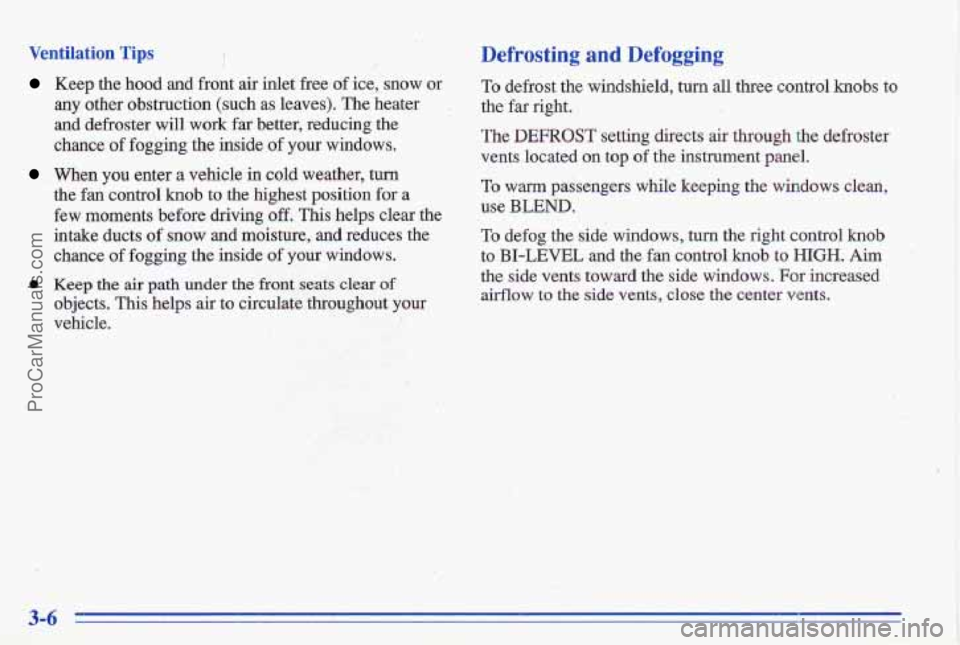
Ventilation Tips I
Keep the hood and front air inlet free of ice, snow or
any other obstruction (such as leaves). The heater
and defroster will work
far better, reducing the
chance
of fogging the inside of your windows.
When you enter a 'vehicle in cold weather, turn
the fan control
knob to the highest position for a
few moments before driving off. This helps clear the
intake ducts
of snow and moisture, and reduces the
chance of
fogging the inside of your windows.
0 Keep the air path under the front ,seats clear of
objects. This helps air to circulate throughout your
vehicle.
Defrosting and Defogging
To defrost the windshield, turn all three control knobs to
the far right.
The
DEFROST setting directs ais through the defroster
vents located
on top of the instrument panel.
To warm passengers while keeping the windows cleari,
use
B'LEND.
To defog the side windows, turn the right control knob
to BI-LEVEL and the fan control knob to HIGH. Aim
the side vents toward the side windows. For increased airflow to
the side vents, close the center vents.
3-6
ProCarManuals.com
Page 181 of 356
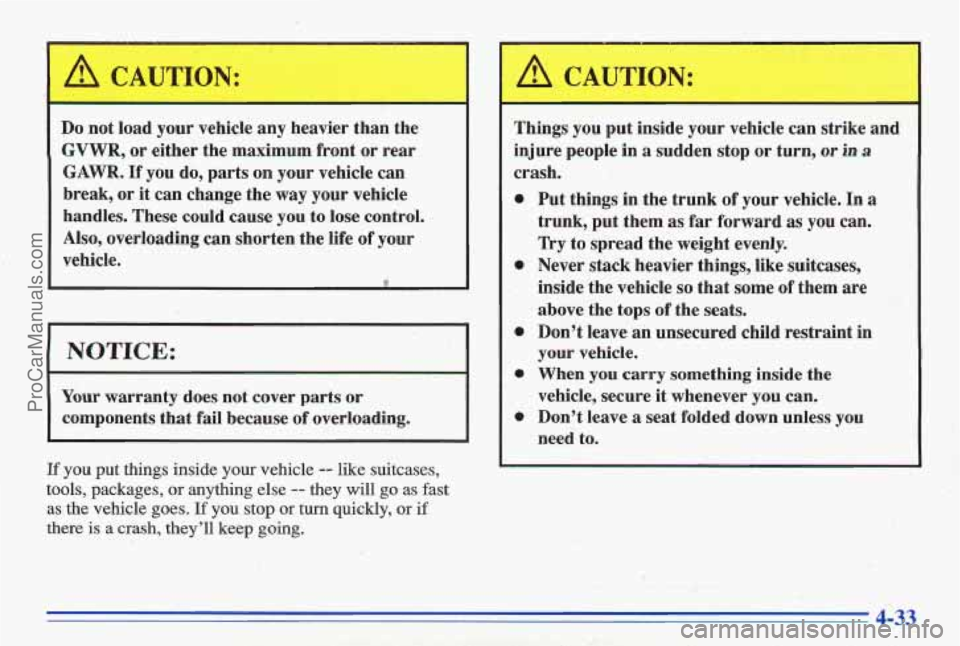
Do not load your vehicle any heavier than the
GVWR, or either the maximum front or rear
GAWR. If you do, parts on your vehicle can
break, or it can change the way your vehicle
handles. These could cause you to lose control.
Also, overloading can shorten the life of your
vehicle.
I NOTICE: I
I
Your warranty does not cover parts or
components that fail because of overloading.
If you put things inside your vehicle -- like suitcases,
tools, packages, or anything else -- they will go as fast
as the vehicle goes. If you stop or turn quickly, or if
there
is a crash, they'll keep going.
A CAUTION:
Things you put inside your vehicle can strike and
injure people in
a sudden stop or turn, or in a
crash. 3 ' :: ,.." . . ;.-. . ,. .,_.. i- , . .: .'. . . .. , , ..? - >. . . . . . . . . .. . .. - ' . .q. ..
0
0
0
0
0
Put things in the trunk of your vehicle. In a
trunk, put them as far forward as you can.
Try to spread the weight evenly.
Never stack heavier things, like suitcases,
inside the vehicle
so that some of them are
above the tops
of the seats.
Don't leave an unsecured child restraint in
your vehicle.
When you carry something inside the
vehicle, secure it whenever you can.
Don't leave
a seat folded down unless you
need to.
ProCarManuals.com